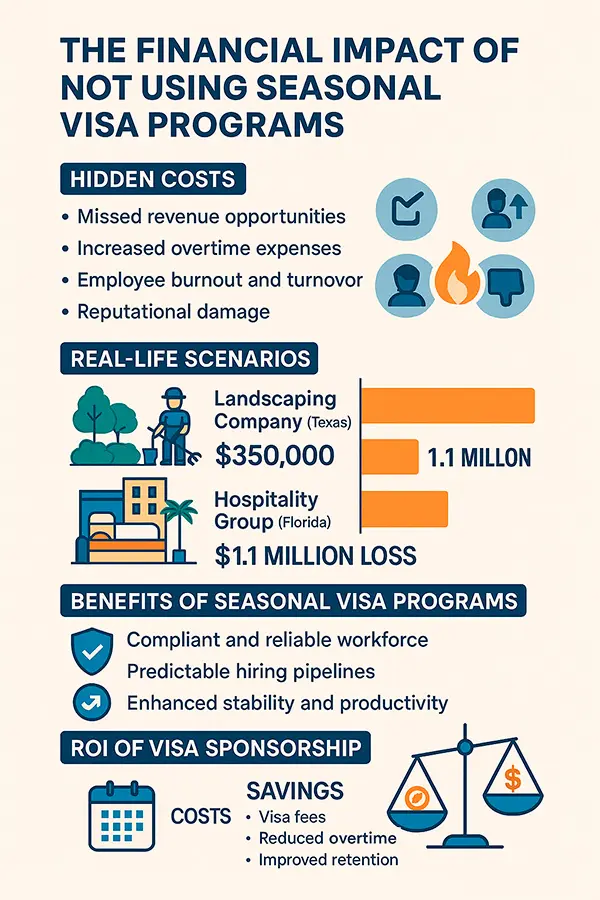In the world of business, few things are as costly and disruptive as unfilled jobs. When companies fail to tap into seasonal visa programs like the H-2A and H-2B, they’re not just missing out on workers—they’re losing money, time, and opportunity. For industries dependent on seasonal labor, such as agriculture, hospitality, landscaping, and construction, the decision to forgo or delay visa sponsorship has tangible, often painful consequences. This article explores the full financial impact of not using seasonal visa programs—and why the cost of doing nothing can be far greater than the investment in a compliant, efficient recruitment process.
The Hidden Cost of Unfilled Roles
When businesses can’t find enough workers to meet demand, it triggers a domino effect:
- Missed revenue opportunities from contracts that can’t be fulfilled
- Increased overtime costs for the remaining staff
- Worker burnout leading to high turnover and even more hiring needs
- Reputational damage from poor service delivery or production delays
Scenario 1: A Landscaping Company in Texas
A midsize landscaping company in San Antonio relies heavily on H-2B workers during the spring and summer. One year, delays in petition filing led to the company missing the cap. The result?
- 8 unfilled positions
- $280,000 in missed contracts
- $42,000 in overtime paid to current staff
- 3 resignations due to burnout
Total estimated financial loss: Over $350,000 in a single season.
Scenario 2: A Hospitality Group in Florida
A resort chain with 3 properties couldn’t secure their usual seasonal H-2B workers on time. They tried hiring domestically but could only fill 60% of roles.
- Room occupancy was reduced by 25%
- Revenue dropped by 15% during peak season
- Online reviews cited long waits and unclean rooms
The CFO estimated the lost revenue at $1.1 million.
What Seasonal Visa Programs Offer
- A legal and compliant workforce
- Predictable seasonal hiring pipelines
- Workers with relevant experience
- Stability in industries known for fluctuation
The True ROI of Visa Sponsorship
Many companies hesitate to use H-2B or H-2A programs because of perceived costs. But when you calculate the real numbers, the return on investment is clear.
Missed Contracts: The Invisible Opportunity Loss
Businesses often focus on direct costs—wages, paperwork, etc. But the biggest financial blow comes from opportunity cost.
Overtime and Its Hidden Toll
Paying existing staff to work extra hours seems like a temporary fix, but it adds up quickly.
Burnout and Employee Retention
When teams are short-staffed, morale suffers. Employees are forced to pick up the slack.
Compliance vs. Risk
Using proper visa channels like H-2A and H-2B ensures stability and legal protection.
When Recruitment Is Strategic, Not Reactive
Smart companies treat seasonal visa recruitment as part of their overall talent strategy.

Case Study: 3A Immigration Services Client Outcome
- 100% roles filled by peak season
- $800K in added revenue from higher occupancy
- 40% reduction in turnover
3A Immigration Services: Your Trusted Partner in Seasonal Workforce Planning
At 3A Immigration Services, we specialize in helping businesses like yours navigate seasonal visa programs with ease.
Conclusion: The Cost of Doing Nothing
Not using seasonal visa programs isn’t a neutral decision—it’s a costly one. Between missed contracts, overtime, burnout, and compliance risks, companies pay dearly for staffing gaps. In contrast, investing in a seasonal visa strategy pays off through increased revenue, happier employees, and long-term growth.
Seasonal visa programs are not just a hiring tool—they’re a financial safeguard. They ensure that your operations remain stable, your clients stay satisfied, and your workforce remains resilient and reliable throughout the most demanding parts of the year. In today’s tight labor market, companies that fail to leverage these programs risk falling behind.
Businesses that plan ahead, take advantage of legal hiring avenues, and partner with experienced immigration service providers are positioning themselves not just to survive—but to thrive.
If your bottom line matters, and if long-term growth is part of your company’s vision, it’s time to make seasonal workforce planning a top priority. Because inaction has a cost—and it’s one your company can’t afford.
External Resources





